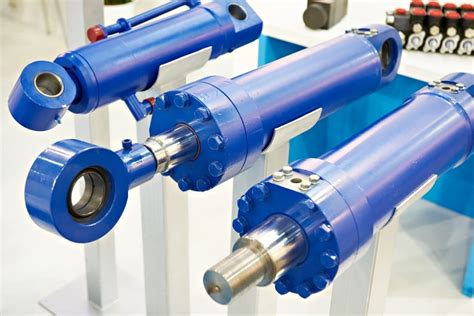Hydraulic Cylinder Seal Replacement: Maintain Peak Hydraulic Performance
Hydraulic cylinders are the workhorses of countless industrial applications, providing powerful linear motion in everything from construction equipment to manufacturing processes. However, the constant pressure and friction within these systems inevitably lead to wear and tear, most notably on the seals. Replacing worn hydraulic cylinder seals is crucial for maintaining peak performance, preventing costly downtime, and ensuring the safety of your operation. This comprehensive guide will explore the importance of timely seal replacement and provide practical insights into the process.
Why are Hydraulic Cylinder Seal Replacements Necessary?
Worn or damaged hydraulic cylinder seals are a major source of hydraulic system failure. Several issues arise from compromised seals, including:
- Leaks: This is the most common symptom. Leaks reduce hydraulic fluid levels, diminishing the cylinder's power and potentially causing complete system failure. Leaks also lead to wasted fluid, increased costs, and potential environmental hazards.
- Reduced Efficiency: Leaks and internal friction caused by damaged seals decrease the efficiency of the hydraulic cylinder, leading to sluggish operation and reduced productivity.
- Contamination: External contaminants can enter the system through damaged seals, leading to internal corrosion and further damage to components.
- Internal Damage: The pressure exerted by damaged seals can cause scoring or scratching within the cylinder, leading to premature wear and tear on other components.
- Safety Hazards: Leaks can create slippery surfaces, posing safety risks to personnel. In some applications, fluid leaks can even lead to catastrophic failures.
How to Identify Worn Hydraulic Cylinder Seals
Several signs indicate that your hydraulic cylinder seals need replacing:
- Visible Leaks: This is the most obvious sign. Look for fluid dripping or weeping around the cylinder rod or piston.
- Reduced Power: If the cylinder's movement is sluggish or weaker than usual, worn seals could be the culprit.
- Unusual Noises: Hissing, groaning, or squealing sounds may indicate that seals are damaged or worn.
- Slow or Erratic Movement: If the cylinder's movement isn't smooth or consistent, it might signal a problem with the seals.
- Fluid Level Drops: Regularly check the hydraulic fluid reservoir level. Consistent drops indicate a leak, most likely from faulty seals.
What Types of Hydraulic Cylinder Seals Exist?
Several seal types exist, each designed for specific applications and fluid types. Common types include:
- U-Cup Seals: Simple, cost-effective, and widely used for general-purpose applications.
- O-Rings: Used as static or dynamic seals, often in conjunction with other seal types.
- Wipers: Prevent dirt and debris from entering the cylinder, extending seal life.
- Rod Seals: Prevent fluid leakage around the piston rod.
- Piston Seals: Prevent fluid leakage around the piston.
How Often Should Hydraulic Cylinder Seals Be Replaced?
There isn't a one-size-fits-all answer to this question. The frequency of seal replacement depends on several factors, including:
- Operating Conditions: High-pressure, high-temperature, or harsh environments necessitate more frequent replacements.
- Fluid Type: The type of hydraulic fluid used can affect seal lifespan.
- Usage Frequency: Frequent cylinder operation leads to faster seal wear.
- Seal Material: Different seal materials have varying lifespans.
Regular inspections and preventative maintenance are crucial for determining when seal replacement is necessary.
What is Involved in Replacing Hydraulic Cylinder Seals?
Replacing hydraulic cylinder seals is a skilled task. It generally involves:
- Disassembling the Cylinder: Carefully remove the cylinder from the system and dismantle it, following manufacturer's instructions.
- Removing Old Seals: Remove the old seals without damaging the cylinder's internal components.
- Inspecting Cylinder Components: Thoroughly inspect the cylinder for damage or wear. Replace any damaged parts.
- Installing New Seals: Install the new seals correctly to ensure proper sealing and prevent damage. Use appropriate lubricants and tools.
- Reassembling the Cylinder: Reassemble the cylinder carefully, ensuring proper alignment and tightness of all components.
- Testing the Cylinder: Test the cylinder to ensure proper operation and to verify that leaks have been eliminated.
Can I Replace Hydraulic Cylinder Seals Myself?
While some individuals with mechanical expertise might attempt a DIY seal replacement, it's generally advisable to leave this task to qualified hydraulic technicians. Improper installation can lead to further damage to the cylinder and the entire hydraulic system.
What are the Costs Associated with Hydraulic Cylinder Seal Replacement?
The cost varies depending on several factors, including the cylinder size, type of seals, labor costs, and the severity of any additional repairs.
Conclusion
Regular inspection and timely replacement of hydraulic cylinder seals are vital for maintaining the efficiency, safety, and longevity of hydraulic systems. While preventative maintenance and regular inspections are crucial, seeking professional assistance for seal replacement ensures proper installation and minimizes the risk of further damage. By prioritizing proactive maintenance, you can maximize the performance and lifespan of your hydraulic cylinders and avoid costly downtime.

